Analysis of Heavy Metal Contaminants and Mobility in Sewage sludge-soil Mixtures for Sustainable Agricultural Practices
Abstract
:1. Introduction
2. Materials and Methods
2.1. Heavy Metal Speciation
2.2. Soil Samples
2.3. Heavy Metal Accumulation Risk Indicators
2.3.1. Geoaccumulation Index of Heavy Metal in Soil (Igeo)
2.3.2. Risk Assessment Code (RAC)
2.3.3. Element Mobility Ratio (EMR)
3. Results
3.1. Geoaccumulation Index of Heavy Metal in Soil (Igeo)
3.2. Risk Assessment Code (RAC)
3.3. Element Mobility Ratio (EMR)
4. Conclusions
- This research indicates that the total concentration of heavy metals is not a reliable indicator to assess the feasibility of using sewage sludge for agricultural purposes.
- Heavy metals in a more mobile form, when introduced into the soil under dry conditions, transition into less mobile forms, irrespective of their soil class.
- In sewage sludge, all metals except nickel and cadmium exhibited a low migration risk. Conversely, sludge-soil mixtures showed a reduced tendency for metal migration compared to soil alone. This observation is valuable as it suggests that heavy metals introduced into the soil in the form of mixtures are less mobile and are likely to be stabilized in the soil.
- Soil quality does not have a significant impact on the stabilization of heavy metals. However, it is crucial to introduce microorganisms into the soil and expose sludge-soil mixtures to atmospheric conditions, and will be continued in subsequent research.
Author Contributions
Funding
Data Availability Statement
Conflicts of Interest
References
- Basheer, A.O.; Hanafiah, M.M.; Alsaadi, M.A.; Wan Yaacob, W.Z.; Al-Douri, Y.; Bouhemadoug, A. Synthesis and characterization of low-cost carbon nanotubes by chemical vapor deposition for aluminum removal from aqueous solution. Desalination Water Treat. 2021, 214, 440–451. [Google Scholar] [CrossRef]
- Basheer, A.O.; Hanafiah, M.M.; Alsaadi, M.A.; Al-Douri, Y.; Al-Raad, A.A. Synthesis and optimization of high surface area mesoporous date palm fiber-based nanostructured powder activated carbon for aluminum removal. Chin. J. Chem. Eng. 2021, 32, 472–484. [Google Scholar] [CrossRef]
- Lasaridi, K.-E.; Manios, T.; Stamatiadis, S.; Chroni, C.; Kyriacou, A. The Evaluation of Hazards to Man and the Environment during the Composting of Sewage Sludge. Sustainability 2018, 10, 2618. [Google Scholar] [CrossRef]
- Jasińska, A. The importance of heavy metal speciation in the aspect of natural management of sewage sludge. Eng. Environ. Prot. 2018, 21, 239–250. [Google Scholar] [CrossRef]
- Municipal Sewage Sludge Management Strategy 2019–2022. 18 November 2018. Warsaw, In Polish: Strategia Postępowania z Komunalnymi Osadami Ściekowymi Na Lata 2019–2022. 18 listopada 2018 r. Warszawa. Available online: https://www.gov.pl/attachment/2846e2b3-68c7-46eb-b36e-7643e81efd9a (accessed on 29 May 2023).
- Rosiek, K. Directions and Challenges in the Management of Municipal Sewage Sludge in Poland in the Context of the Circular Economy. Sustainability 2020, 12, 3686. [Google Scholar] [CrossRef]
- Basheer, A.O.; Hanafiah, M.M.; Alsaadi, M.A.; Wan Yaacob, W.Z.; Al-Douri, Y. Synthesis, Characterization, and Analysis of Hybrid Carbon Nanotubes by Chemical Vapor Deposition: Application for Aluminum Removal. Polymers 2020, 12, 1305. [Google Scholar] [CrossRef] [PubMed]
- Nartowska, E.; Kozłowski, T.; Kolankowska, M. The changes in the microstructure of ion-exchanged clays. E3S Web Conf. 2017, 17, 00063. [Google Scholar] [CrossRef]
- Sobolewska-Mikulska, K.; Cienciała, A. Legal-Surveying Documentation in the Registration of Rights to Properties of the Treasury and of Territorial Self-government Units–Case Study of Poland. Real Estate Manag. Valuat. 2020, 28, 76–88. [Google Scholar] [CrossRef]
- Minister of the Environment. Regulation of the Minister of the Environment of 6 February 2015 on the Municipal Sewage Sludge (J. L. 2015, No. 0, Item. 257); Minister of the Environment: Warsaw, Poland, 2015.
- Nunes, N.; Ragonezi, C.; Gouveia, C.S.S.; Pinheiro de Carvalho, M.Â.A. Review of Sewage Sludge as a Soil Amendment in Relation to Current International Guidelines: A Heavy Metal Perspective. Sustainability 2021, 13, 2317. [Google Scholar] [CrossRef]
- Żukowska, G.; Myszura-Dymek, M.; Roszkowski, S.; Olkiewicz, M. Selected Properties of Soil-like Substrates Made from Mine Coal Waste and Their Effect on Plant Yields. Sustainability 2023, 15, 13341. [Google Scholar] [CrossRef]
- Tessier, A.; Campbell, P.G.C.; Bisson, M. Sequential extraction procedure for the speciation of particulate trace metals. Anal. Chem. 1979, 51, 844–851. [Google Scholar] [CrossRef]
- Available online: https://ec.europa.eu/eurostat/databrowser/view/ten00030/default/bar?lang=en (accessed on 6 December 2022).
- European Commission. Council Directive of 12 June 1986 on the Protection of the Environment, and in Particular of the Soil, When Sewage Sludge Is Used in Agriculture (86/278/EEC); European Commission: Brussels, Belgium, 1986.
- Ministry of Environmental Protection of the People’s Republic of China. Discharge Standard of Pollutants for Municipal Wastewater Treatment Plant; Ministry of Environmental Protection of the People’s Republic of China: Beijing, China, 2002.
- Code of Federal Regulations. Protection of Environment. In Chapter I—Environmental Protection Agency (Continued), Subchapter O—Sewage Sludge, Part 503—Standards for the Use or Disposal of Sewage Sludge, Subpart B—Land Application, Section 503.13—Pollutant limits. 1 July 2010; Office of the Federal Register (United States): Washington, DC, USA, 2010. [Google Scholar]
- Water Research Commission. Guidelines for the Utilisation and Disposal of Wastewater Sludge. Vol. 2. Requirements for the Agricultural Use of Wastewater Sludge; WRC Report no: TT 262/06; WRC: Pretoria, South Africa, 2009. [Google Scholar]
- Government of Netherlands. Decision of 30 January 1998 Laying Down Rules on the Quality and the Placing on the Market of other Organic Fertilizers (Decision Quality and Use of Other Organic Fertilizers). Available online: https://wetten.overheid.nl/BWBR0009360/2006-01-01 (accessed on 6 September 2022). (In Dutch)
- The Sludge (Use in Agriculture) Regulations (Northern Ireland) 1990 Implement Council Directive 86/278/EEC on the Protection of Public Health. Available online: https://www.daera-ni.gov.uk/articles/sewage-sludge (accessed on 29 May 2023).
- Government of Malta. Legal Notice 212 of 28 June 2002 on Sludge (Use in Agriculture) Regulations. Available online: http://www.justiceservices.gov.mt/DownloadDocument.aspx?app=lom&itemid=11496&l=1 (accessed on 8 September 2022).
- Bolan, N.; Kunhikrishan, A.; Thangarajan, R.; Kumpiene, J. Remediation of heavy metal(loid)s contaminated soils—To mobilize or to immobilize? J. Hazard. Mater. 2014, 266, 141–166. [Google Scholar] [CrossRef] [PubMed]
- Akita, M.; Kimura, O.; Atobe, K.; Endo, T.; Yamada, S.; Haraguchi, K.; Kato, Y. Teratogenic Effects of Organohalogen Contaminants Extracted from Whale Bacon in a Whole-Rat-Embryo Culture System. Int. J. Environ. Res. Public Health 2022, 19, 12065. [Google Scholar] [CrossRef]
- Wilk, M.; Śliz, M.; Czerwińska, K.; Śledź, M. The effect of an acid catalyst on the hydrothermal carbonization of sewage sludge. J. Environ. Manag. 2023, 345, 118820. [Google Scholar] [CrossRef]
- Tytła, M.; Widziewicz, K.; Zielewicz, E. Heavy metals and its chemical speciation in sewage sludge at different stages of processing. Environ. Technol. 2016, 37, 899–908. [Google Scholar] [CrossRef]
- Tytła, M.; Widziewicz-Rzońca, K.; Kernert, J.; Bernaś, Z.; Słaby, K. First Comprehensive Analysis of Potential Ecological Risk and Factors Influencing Heavy Metals Binding in Sewage Sludge from WWTPs Using the Ultrasonic Disintegration Process. Water 2023, 15, 666. [Google Scholar] [CrossRef]
- Latosińska, J.; Kowalik, R.; Gawdzik, J. Risk assessment of soil contamination with heavy metals from municipal sewage sludge. Appl. Sci. 2021, 11, 548–561. [Google Scholar] [CrossRef]
- Kowalik, R.; Latosińska, J.; Gawdzik, J. Risk Analysis of Heavy Metal Accumulation from Sewage Sludge of Selected Wastewater Treatment Plants in Poland. Water 2021, 13, 2070. [Google Scholar] [CrossRef]
- Tang, X.; Wu, Y.; Han, L.; Lan, Z.; Rong, X. Characteristics of heavy metal migration in farmland. Environ. Earth Sci. 2022, 81, 338. [Google Scholar] [CrossRef]
- Li, D.N.; Shan, R.; Jiang, L.X.; Gu, J.; Zhang, Y.Y.; Yuan, H.R.; Chen, Y. A review on the migration and transformation of heavy metals in the process of sludge pyrolysis. Resour. Conserv. Recycl. 2022, 185, 106452. [Google Scholar] [CrossRef]
- Terzaghi, K.; Peck, R.B. Soil Mechanics in Engineering Practice, 2nd ed.; Wiley: New York, NY, USA, 1967. [Google Scholar]
- Soil Survey Staff Keys to Soil Taxonomy, 13th ed.; U.S. Department of Agriculture, Natural Resources Conservation Service: Washington, DC, USA, 2022.
- Lee, D.-B.; Kim, Y.-N.; Sonn, Y.-K.; Kim, K.-H. Comparison of Soil Taxonomy (2022) and WRB (2022) Systems for Classifying Paddy Soils with Different Drainage Grades in South Korea. Land 2023, 12, 1204. [Google Scholar] [CrossRef]
- Muller, G. Index of geoaccumulation in sediments of the Rhine River. GeoJournal 1969, 2, 108–118. [Google Scholar]
- Hakanson, L. An ecological risk index for aquatic pollution control: A sedimentological approach. Water Res. 1980, 14, 975–1001. [Google Scholar] [CrossRef]
- Kowalik, R.; Gawdzik, J.; Bąk-Patyna, P.; Ramiączek, P.; Jurišević, N. Risk Analysis of Heavy Metals Migration from Sewage Sludge of Wastewater Treatment Plants. Int. J. Environ. Res. Public Health 2022, 19, 11829. [Google Scholar] [CrossRef] [PubMed]
- Perin, G.; Craboledda, L.; Lucchese, M.; Cirillo, R.; Dotta, L.; Zanetta, M.L.; Oro, A.A. Heavy metal speciation in the sediments of northern Adriatic Sea. A new approach for environmental toxicity determination. In Heavy Metals in the Environment; Lakkas, T.D., Ed.; CEP Consultants: Edinburgh, UK, 1985; Volume 2, pp. 454–456. [Google Scholar]
- Đurđević, D.; Blecich, P.; Jurić, Ž. Energy Recovery from Sewage Sludge: The Case Study of Croatia. Energies 2019, 12, 1927. [Google Scholar] [CrossRef]
- Nartowska, E.; Styś-Maniara, M.; Kozłowski, T. The Potential Environmental and Social Influence of the Inorganic Salt Hydrates Used as a Phase Change Material for Thermal Energy Storage in Solar Installations. Int. J. Environ. Res. Public Health 2023, 20, 1331. [Google Scholar] [CrossRef] [PubMed]

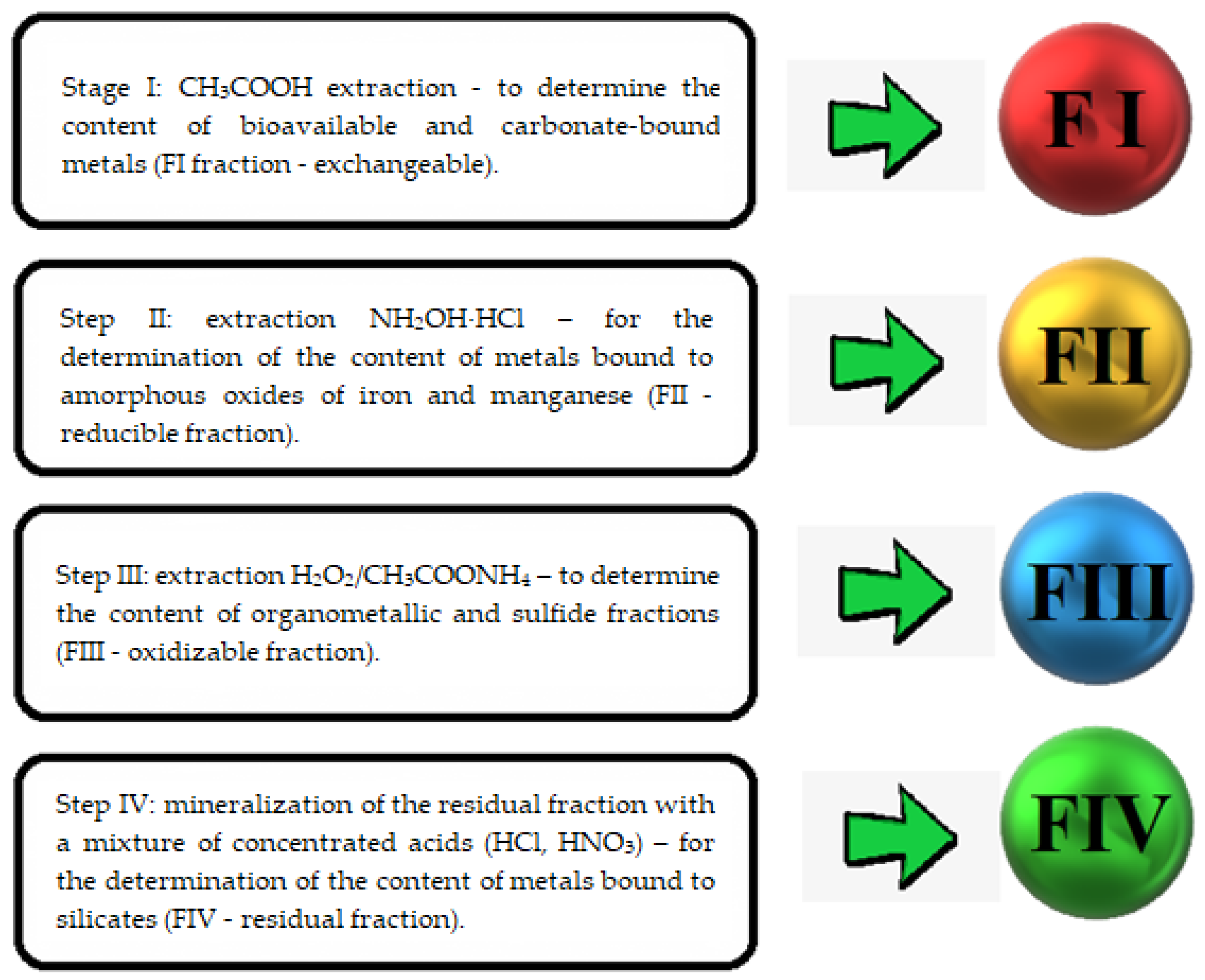
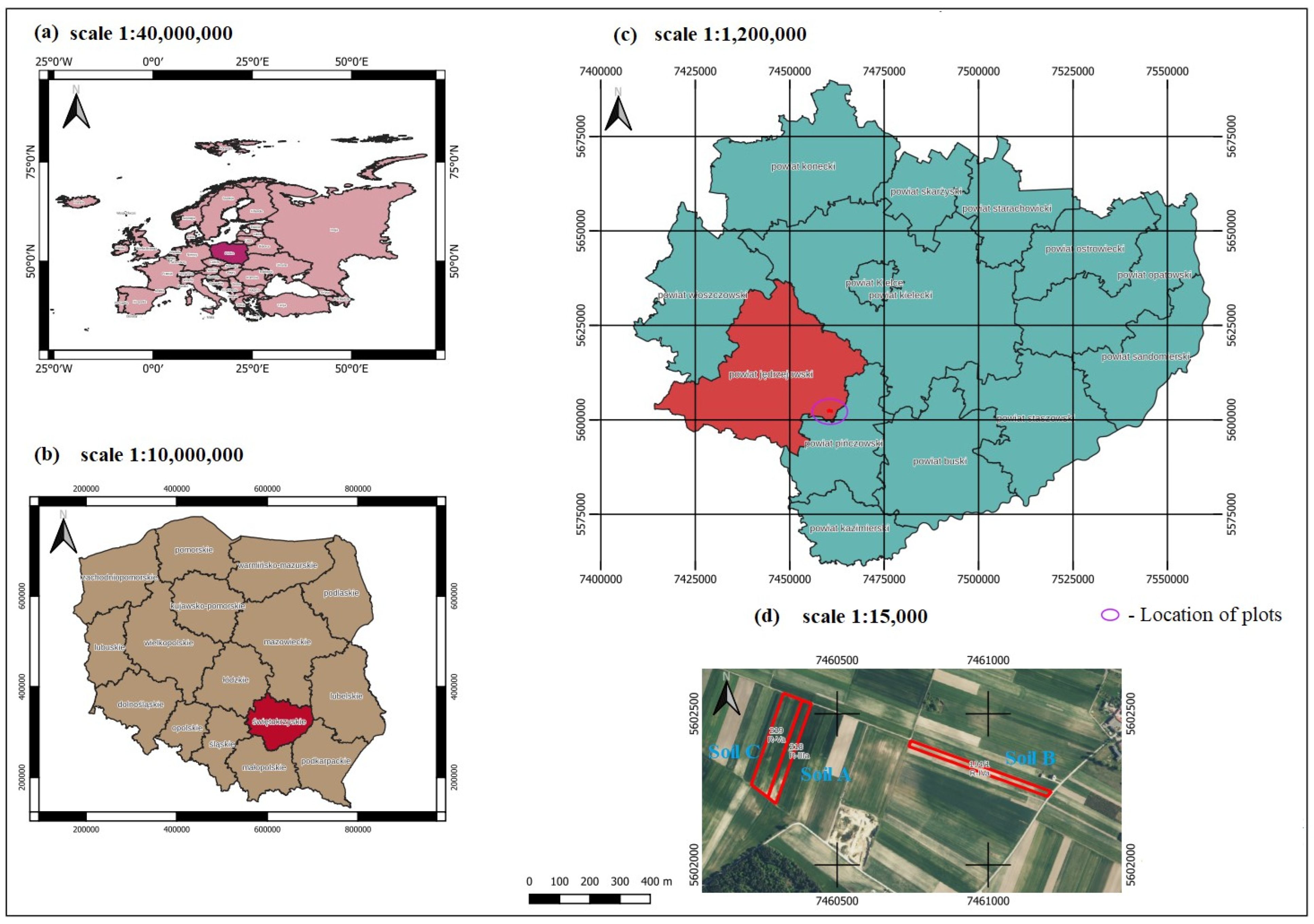
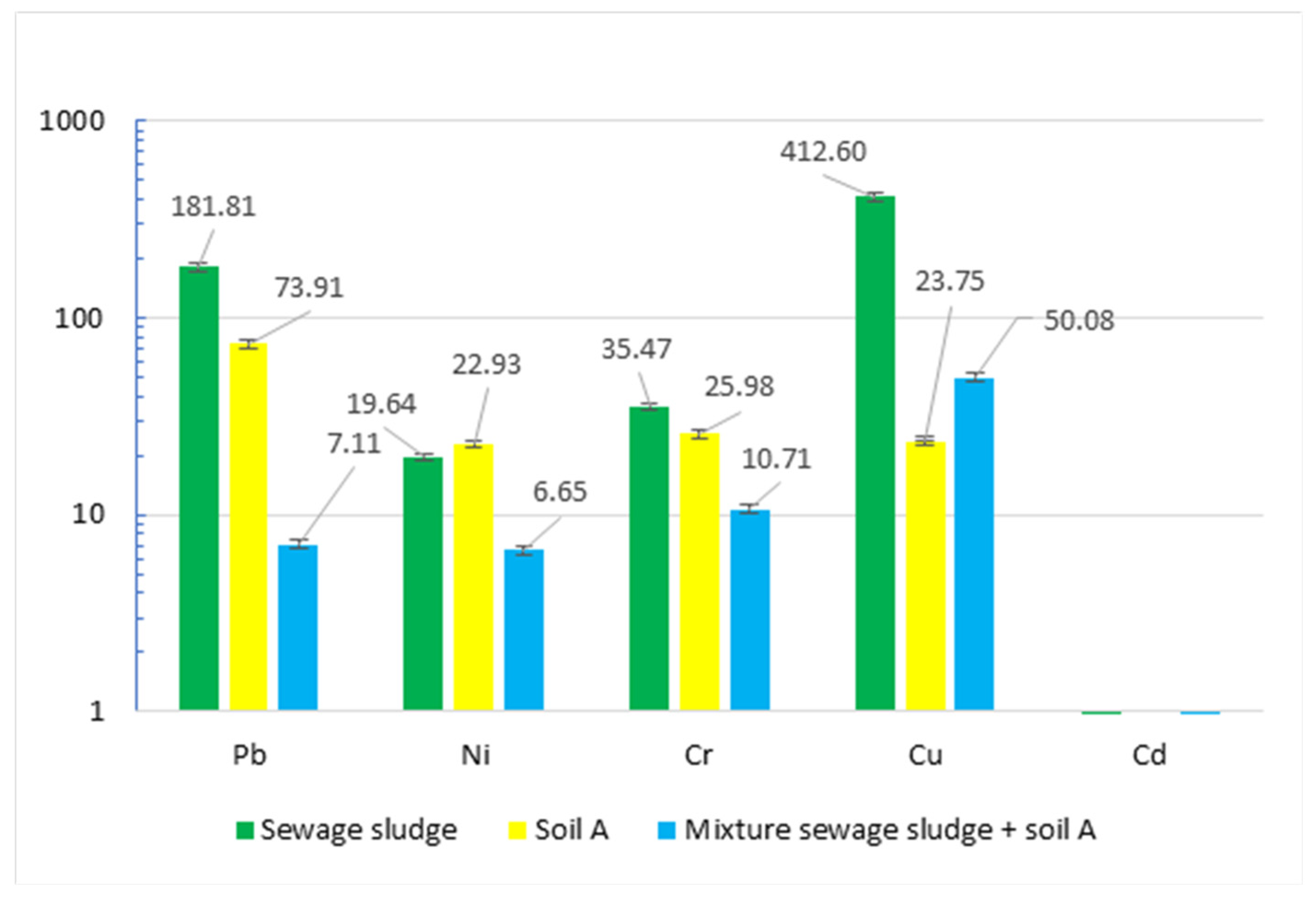
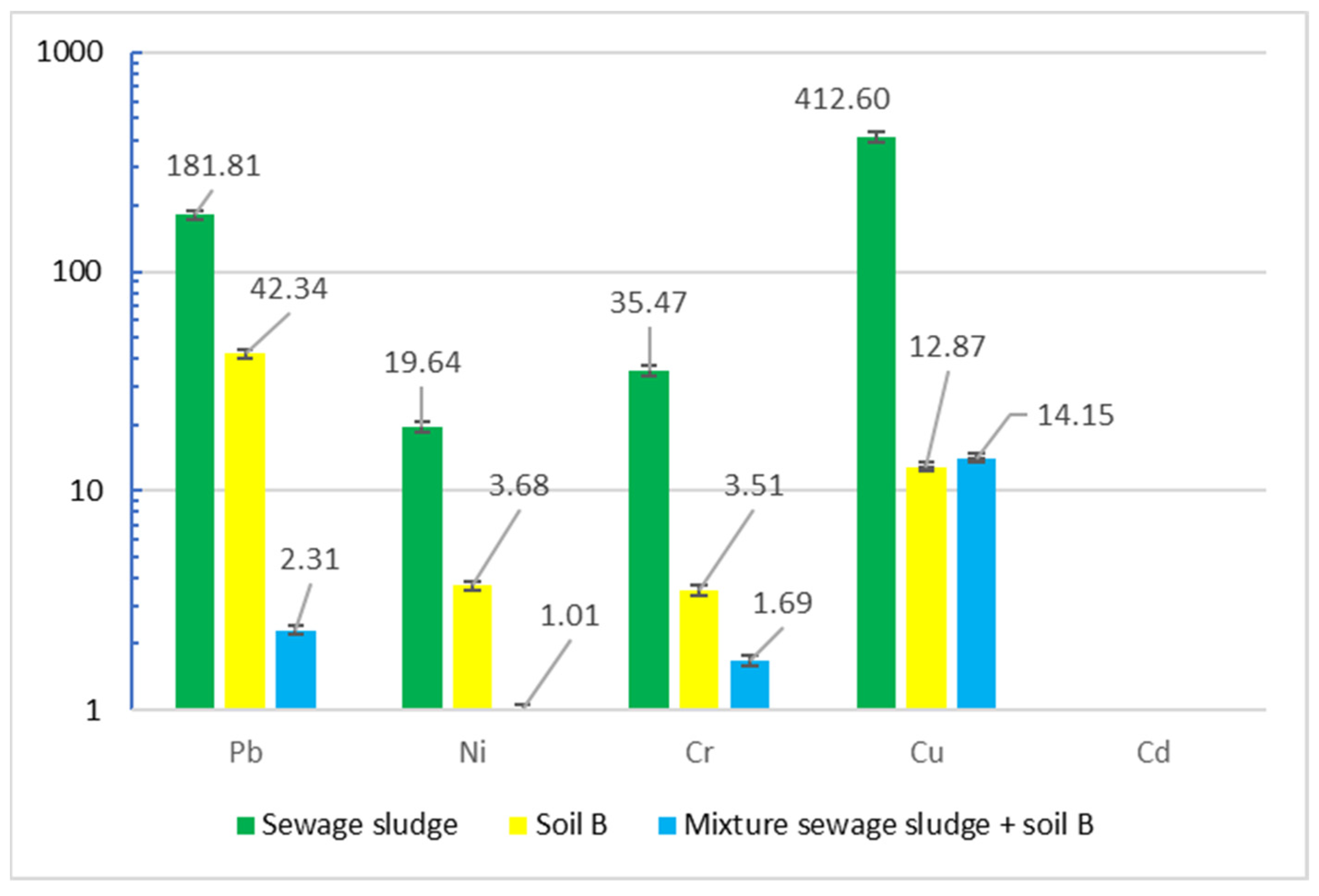
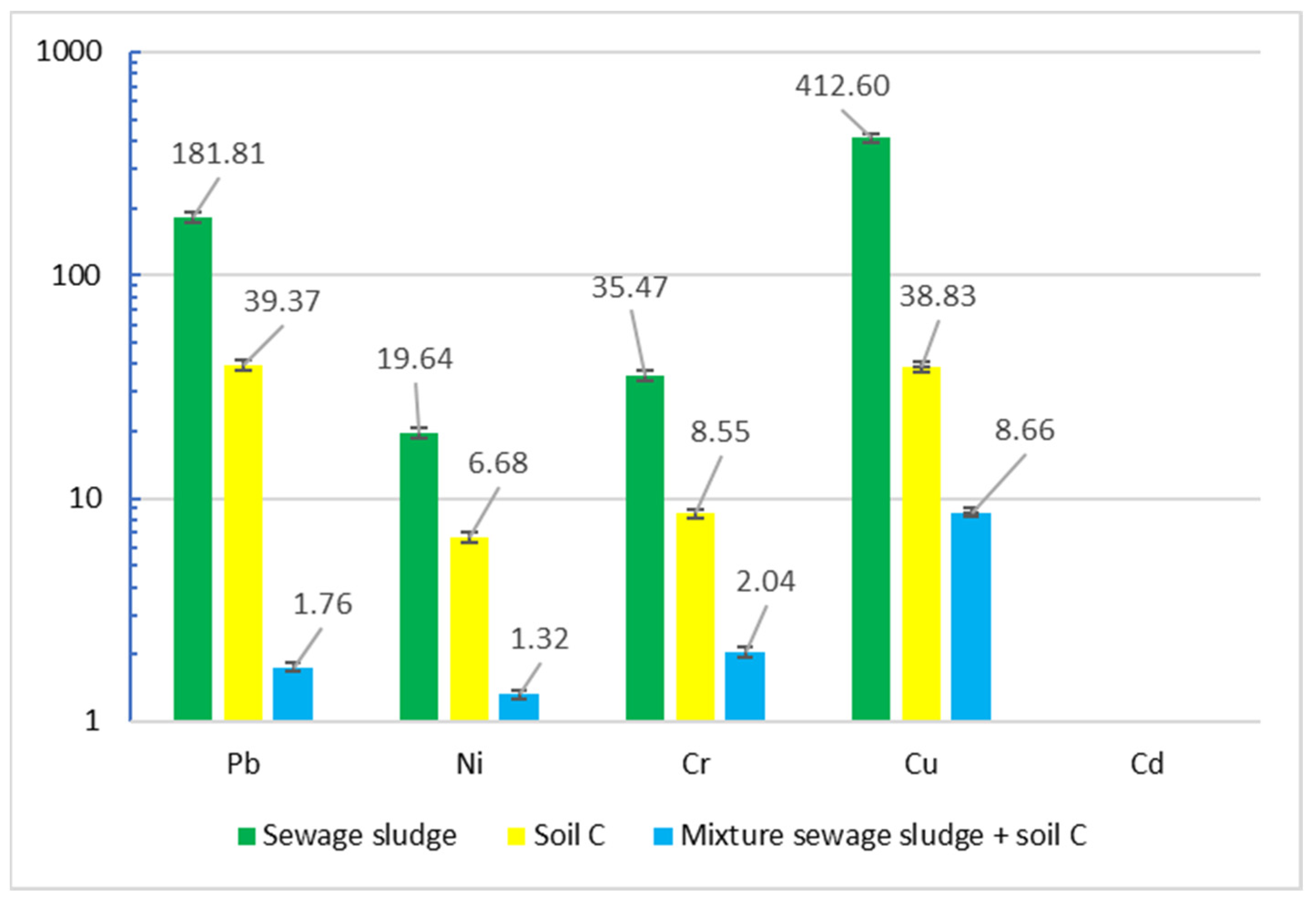
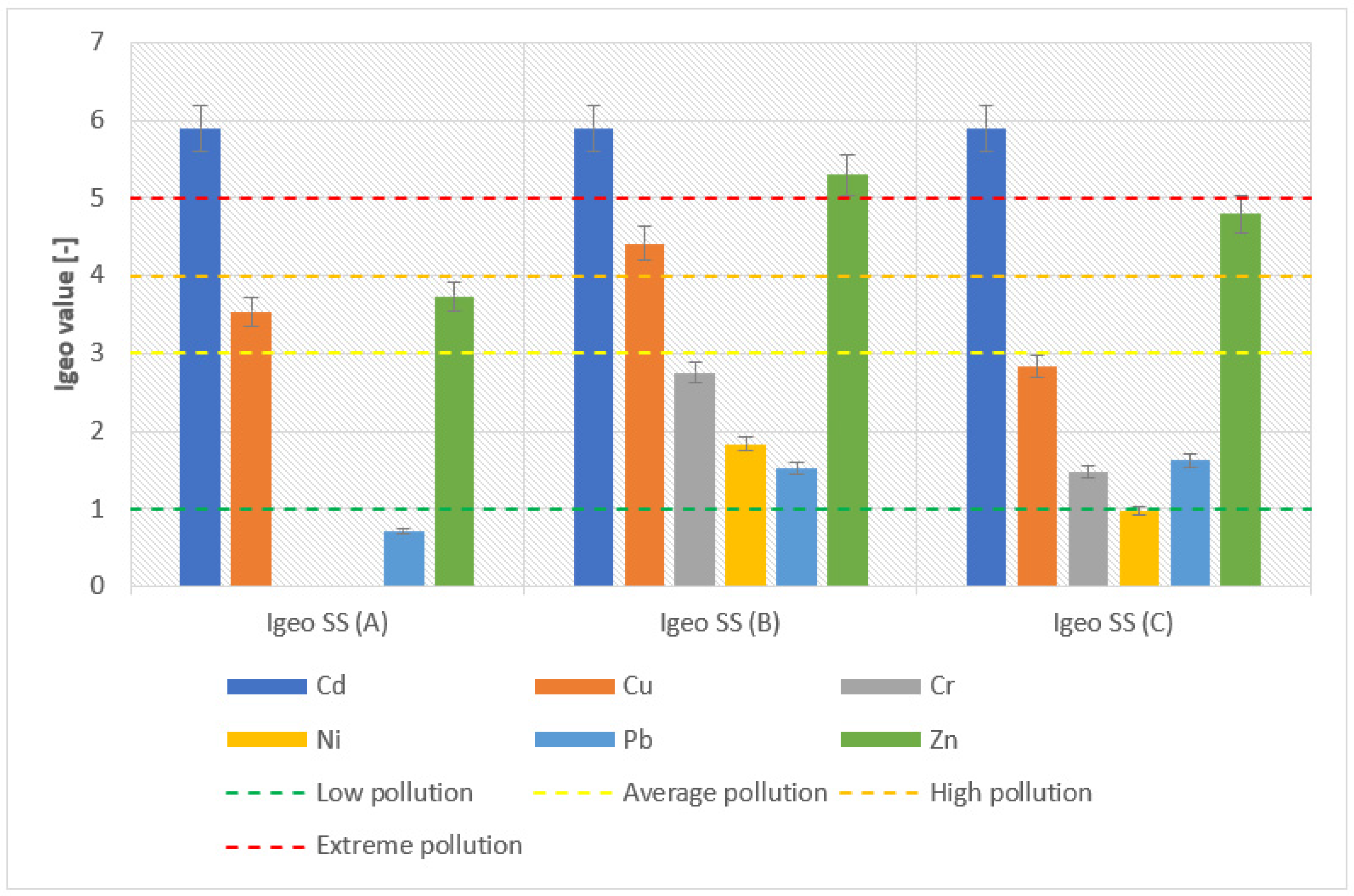

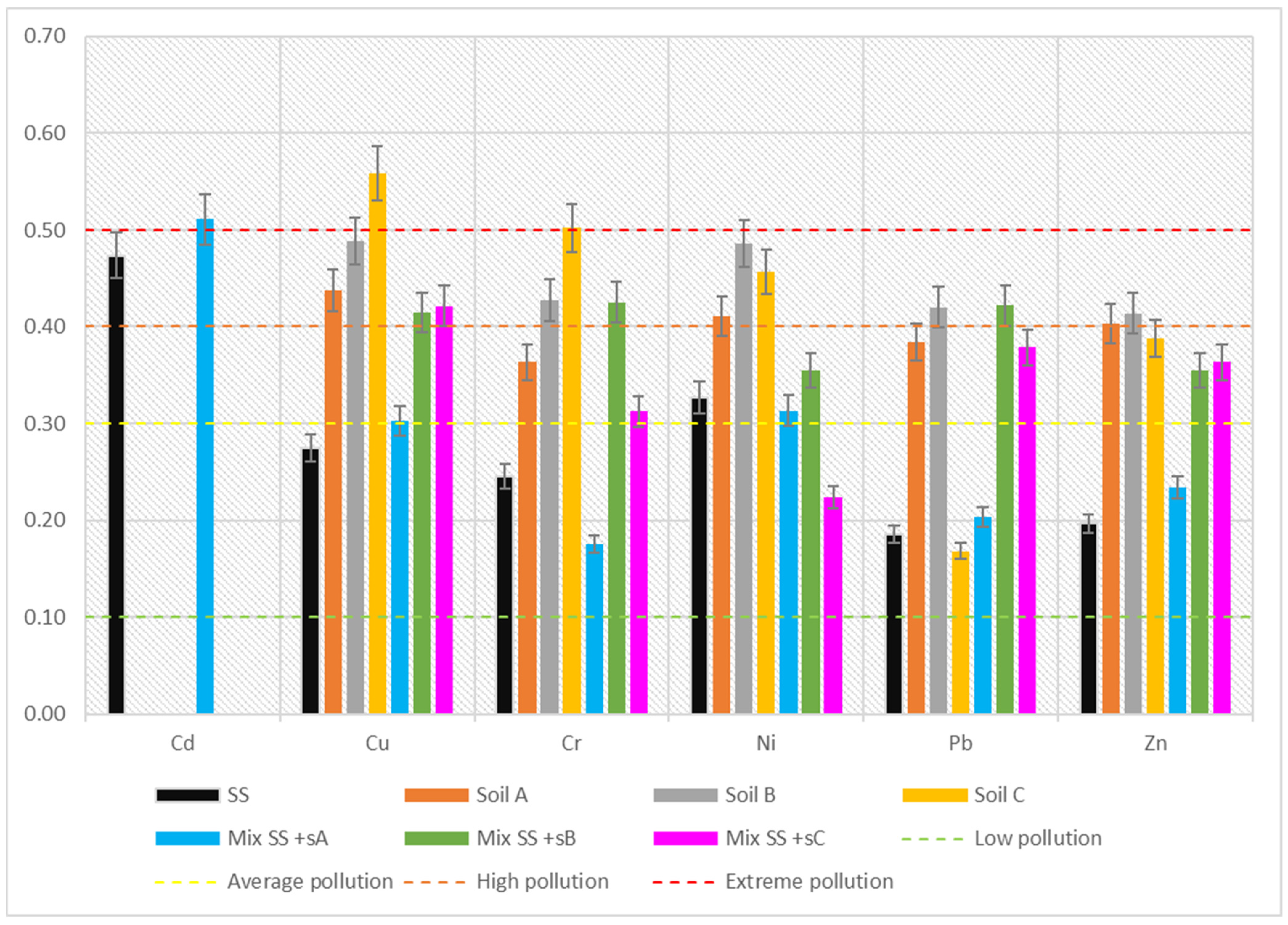
| Heavy Metal | The Allowable Concentrations of Heavy Metals Present in Sewage Sludge Intended for Natural Utilization | |||||||||||
|---|---|---|---|---|---|---|---|---|---|---|---|---|
| Poland [10] | EU [15] | Chinese [16] | United States [17] | South African [18] | Netherlands [19] | Ireland [20] | Malta [21] | |||||
| In Agriculture and for Reclamation Land for Agricultural Purposes | For the Reclamation of of Land for Non-Agricultural Purposes | When Adapting Land to Specific Needs Arising from Waste Management Plans, Spatial Development Plans | pH < 6.5 | pH > 6.5 | ||||||||
| Cd | 20 | 25 | 50 | 20–40 | 5 | 20 | 39 | 40 | 1.25 | 20 | 5 | |
| Ni | 300 | 400 | 500 | 300–400 | 100 | 200 | 420 | 420 | 30 | 300 | 200 | |
| Cr | 500 | 1000 | 2500 | - | 600 | 1000 | - | 1200 | 75 | - | 800 | |
| Pb | 750 | 1000 | 1500 | 750–1200 | 300 | 1000 | 300 | 300 | 100 | 750 | 500 | |
| Cu | 1000 | 1200 | 2000 | 1000–1750 | 250 | 500 | 1500 | 1500 | 75 | 1000 | 800 | |
| Zn | 2500 | 3500 | 5000 | 2500–4000 | 500 | 1000 | 2800 | 2800 | 300 | 2500 | 2000 | |
| Soil Sample | Content of Fraction (%) | pH (KCl) | Organic Matter Content | Organic Carbon | Nitrogen Total | C/N Ratio | Absorbable Phosphorus | Soil Sorption Capacity | ||
|---|---|---|---|---|---|---|---|---|---|---|
| - | fi < 2 μm | 2 < fπ < 50 μm | 50 < fp < 2000 μm | pH | % | % | % | - | mg P2O5 × 100 g−1 | Cmol/kg |
| Soil A | 45 | 40 | 15 | 5.6 | 4.21 | 2.33 | 0.19 | 12.49 | 6.4 | 36.8 |
| Soil B | 30 | 51 | 19 | 5.2 | 3.19 | 1.81 | 0.12 | 15.42 | 5.7 | 11.8 |
| Soil C | 8 | 28 | 64 | 6.7 | 0.78 | 0.56 | 0.06 | 22.27 | 1.2 | 5.3 |
| Igeo | RAC | EMR | Risk Value |
|---|---|---|---|
| Igeo ≤ 0 | <0.01 | 0 < EMR ≤ 0.1 | Lack of pollution |
| 0 < Igeo ≤ 1 | 0.01 ÷ 0.1 | 0.1 < EMR ≤ 0.3 | Low pollution |
| 1 < Igeo ≤ 3 | 0.11 ÷ 0.3 | 0.3 < EMR ≤ 0.4 | Average pollution |
| 3 < Igeo ≤ 5 | 0.31 ÷ 0.5 | 0.4 < EMR ≤ 0.5 | High pollution |
| 5 < Igeo | >0.5 | 0.5 < EMR | Extreme pollution |
Disclaimer/Publisher’s Note: The statements, opinions and data contained in all publications are solely those of the individual author(s) and contributor(s) and not of MDPI and/or the editor(s). MDPI and/or the editor(s) disclaim responsibility for any injury to people or property resulting from any ideas, methods, instructions or products referred to in the content. |
© 2023 by the authors. Licensee MDPI, Basel, Switzerland. This article is an open access article distributed under the terms and conditions of the Creative Commons Attribution (CC BY) license (https://creativecommons.org/licenses/by/4.0/).
Share and Cite
Janaszek, A.; Kowalik, R. Analysis of Heavy Metal Contaminants and Mobility in Sewage sludge-soil Mixtures for Sustainable Agricultural Practices. Water 2023, 15, 3992. https://doi.org/10.3390/w15223992
Janaszek A, Kowalik R. Analysis of Heavy Metal Contaminants and Mobility in Sewage sludge-soil Mixtures for Sustainable Agricultural Practices. Water. 2023; 15(22):3992. https://doi.org/10.3390/w15223992
Chicago/Turabian StyleJanaszek, Agata, and Robert Kowalik. 2023. "Analysis of Heavy Metal Contaminants and Mobility in Sewage sludge-soil Mixtures for Sustainable Agricultural Practices" Water 15, no. 22: 3992. https://doi.org/10.3390/w15223992
APA StyleJanaszek, A., & Kowalik, R. (2023). Analysis of Heavy Metal Contaminants and Mobility in Sewage sludge-soil Mixtures for Sustainable Agricultural Practices. Water, 15(22), 3992. https://doi.org/10.3390/w15223992







